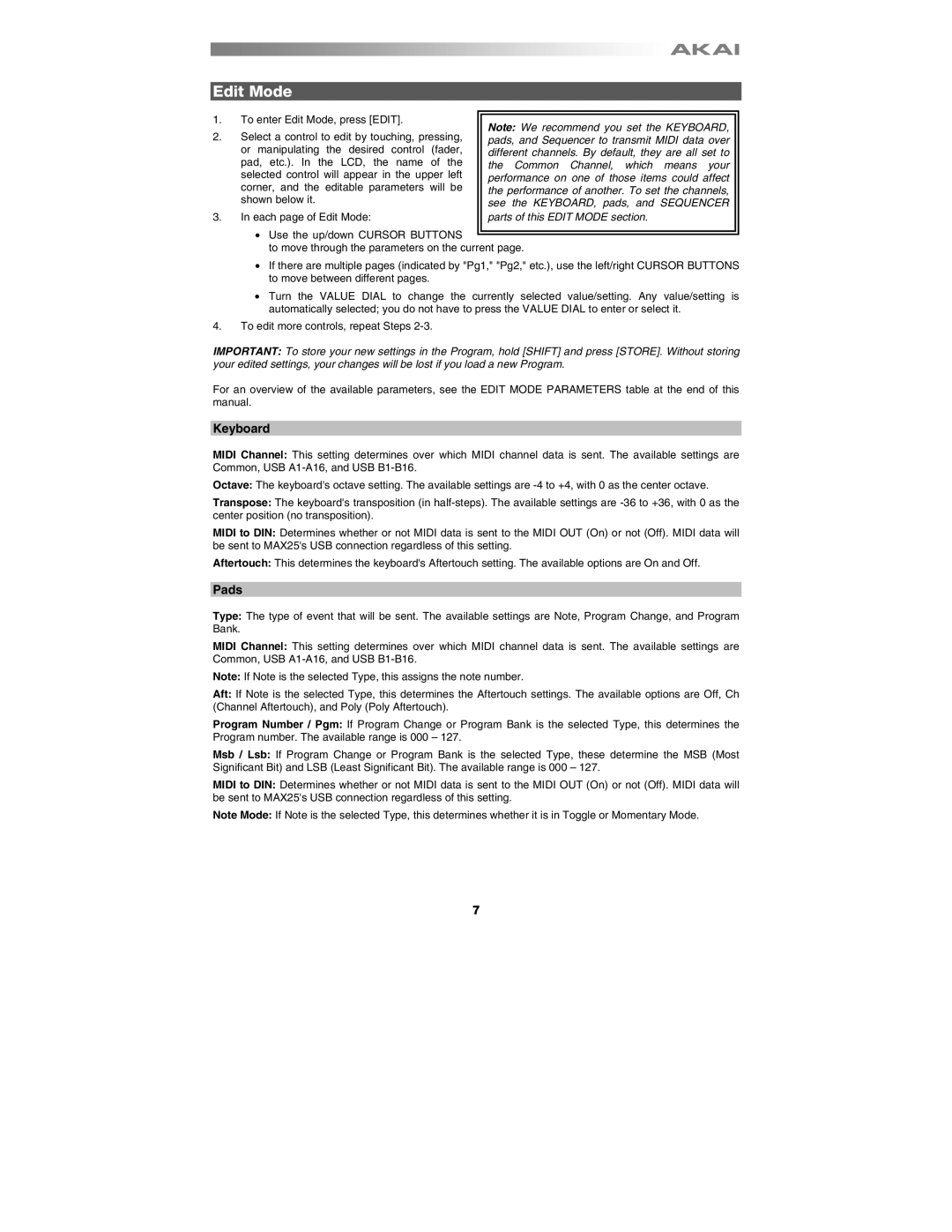
Edit Mode
1.To enter Edit Mode, press [EDIT].
2.Select a control to edit by touching, pressing, or manipulating the desired control (fader, pad, etc.). In the LCD, the name of the selected control will appear in the upper left corner, and the editable parameters will be shown below it.
3.In each page of Edit Mode:
Note: We recommend you set the KEYBOARD, pads, and Sequencer to transmit MIDI data over different channels. By default, they are all set to the Common Channel, which means your performance on one of those items could affect the performance of another. To set the channels, see the KEYBOARD, pads, and SEQUENCER parts of this EDIT MODE section.
•Use the up/down CURSOR BUTTONS
to move through the parameters on the current page.
•If there are multiple pages (indicated by "Pg1," "Pg2," etc.), use the left/right CURSOR BUTTONS to move between different pages.
•Turn the VALUE DIAL to change the currently selected value/setting. Any value/setting is automatically selected; you do not have to press the VALUE DIAL to enter or select it.
4.To edit more controls, repeat Steps
IMPORTANT: To store your new settings in the Program, hold [SHIFT] and press [STORE]. Without storing your edited settings, your changes will be lost if you load a new Program.
For an overview of the available parameters, see the EDIT MODE PARAMETERS table at the end of this manual.
Keyboard
MIDI Channel: This setting determines over which MIDI channel data is sent. The available settings are Common, USB
Octave: The keyboard's octave setting. The available settings are
Transpose: The keyboard's transposition (in
MIDI to DIN: Determines whether or not MIDI data is sent to the MIDI OUT (On) or not (Off). MIDI data will be sent to MAX25's USB connection regardless of this setting.
Aftertouch: This determines the keyboard's Aftertouch setting. The available options are On and Off.
Pads
Type: The type of event that will be sent. The available settings are Note, Program Change, and Program Bank.
MIDI Channel: This setting determines over which MIDI channel data is sent. The available settings are Common, USB
Note: If Note is the selected Type, this assigns the note number.
Aft: If Note is the selected Type, this determines the Aftertouch settings. The available options are Off, Ch (Channel Aftertouch), and Poly (Poly Aftertouch).
Program Number / Pgm: If Program Change or Program Bank is the selected Type, this determines the Program number. The available range is 000 – 127.
Msb / Lsb: If Program Change or Program Bank is the selected Type, these determine the MSB (Most Significant Bit) and LSB (Least Significant Bit). The available range is 000 – 127.
MIDI to DIN: Determines whether or not MIDI data is sent to the MIDI OUT (On) or not (Off). MIDI data will be sent to MAX25's USB connection regardless of this setting.
Note Mode: If Note is the selected Type, this determines whether it is in Toggle or Momentary Mode.
7
